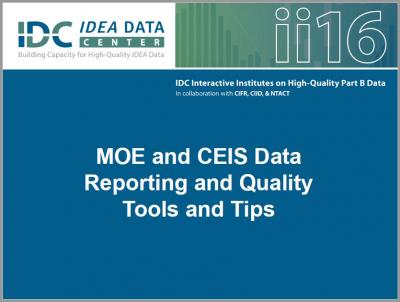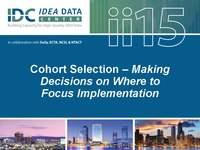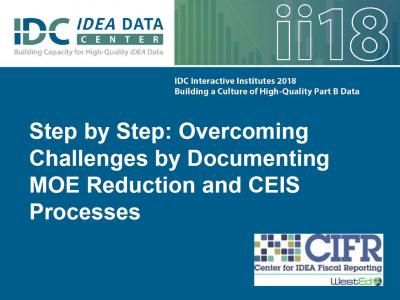Site Search
Results 1 - 4 of 4
Format: Presentations
MOE and CEIS Data Reporting and Quality Tools and TipsIDC and CIFR staff presented an overview of tools available to states and LEAs around LEA MOE and CEIS requirements and data quality. They also presented information on considerations states and LEAs need to keep in mind in relation to the MOE and CEIS requirements and data quality. One state presented information about the policies, procedures, practices, and tools/ templates it has in place to ensure LEAs meet the LEA MOE and CEIS requirements and improve data quality. The state staff also discussed their work with CIFR around the LEA MOE calculator.
Format: Presentations
Cohort Selection - Making Decisions on Where to Focus ImplementationSelection of a cohort, or Transformation Zone, for SSIP implementation is a principle consideration in developing an action plan. The presentation addresses variables that states should considered in making those decisions and provides information on methods to determine readiness and eliciting involvement of an LEA/EIS.
Format: Guides, Papers, and Reports
CEIS Practice GuideThe CEIS Practice Guide provides two scenarios each for voluntary CEIS and comprehensive CEIS. Each scenario describes an LEA’s implementation of voluntary or comprehensive CEIS and how the LEA or state could track the amount LEAs reserved for voluntary or comprehensive CEIS, the activities conducted using IDEA funds for voluntary or comprehensive CEIS, the target group of students, and ongoing student-level data about special education services. IDC and CIFR collaborated to develop the practice guide.
Format: Presentations
Step by Step: Overcoming Challenges by Documenting MOE Reduction and CEIS ProcessesThis workshop explored the benefits of documenting MOE Reduction and CEIS processes for collecting and submitting data to OSEP. Presenters described some of the common challenges that SEAs face with these data. States shared the steps in their processes, who is responsible for the processes, what methodologies they use to collect and review data, and how they consistently validate and report the data.





